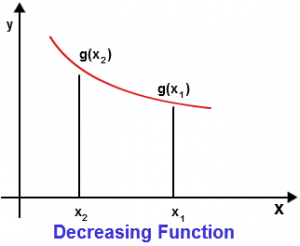Strictly increasing function: A function f(x) is said to be a strictly increases function on (a, b) if x₁ < x₂ ⇒ f (x₁) < f (x₂) ” x₁, x₂ ϵ (a, b). Ex: aˣ is strictly increasing function on R for a > 1.
Ex: aˣ is strictly increasing function on R for a > 1.
F(x) = eˣ is increasing on R.
Strictly decreasing function: A function F(x) is said to be a strictly decreasing function on (a, b) if x₁ < x₂ ⇒ f (x₁) > f (x₂) ” x₁, x₂ ϵ (a, b). F (x) = aˣ (0 < a < 1) is strictly decreasing function.
F (x) = aˣ (0 < a < 1) is strictly decreasing function.
Monotonic function: A function f(x) is said to be monotonic on an interval (a, b) if it is either increasing or decreasing (a, b).
Definition 1: A function f(x) is said to be increasing (decreasing) at a point x₀, if there is an interval (x₀ – h, x₀ + h) containing x₀ such that f(x) is increasing (decreasing) on (x₀ – h, x₀ + h)
Definition 2: A function f(x) is said to be increasing (decreasing) on [a, b] if it is increasing (decreasing) on (a, b) and it is also increasing (decreasing) on (a, b) and it is also increasing (decreasing) at x = a and x = b.
Necessary and sufficient condition Monotonicity of functions:
Necessary condition: Let f(x) be a differentiable function defined on (a, b) then f’(x) > 0 or f’(x) < 0 according as f(x) is increasing or decreasing on (a, b)
If f(x) is an increasing function on (a, b) then tangent at every point on curve y = f(x) makes an acute angle in the positive direction of x – axis.
tan θ > 0 ⇒ dy/dx > 0 Or f’ (x) > 0 ” x ϵ (a, b).
Similarly for decreasing function on (a, b) then the tangent at every point on the curve y = f(x) makes obtuse angle θ with direction of x – axis.
tan θ < 0 ⇒ dy/dx > 0 Or f’ (x) < 0 ” x ϵ (a, b).
Sufficient condition: Let f be a differentiable real function defined on open interval (a, b).
a) If f’(x) > 0 ” x ϵ (a, b), then f is Increasing on (a, b).
b) If f’(x) < 0 ” x ϵ (a, b), then f is decreasing on (a, b).
Properties of Monotonic functions:
i) If f(x) is strictly increasing function on an interval [a, b] then f⁻¹ exists and also a strictly increasing function.
ii) If f(x) is strictly increasing function on an interval [a, b] such that it is continuous then f⁻¹ is continuous on [f (a), f (b)].
iii) If f(x) is continuous on [a, b] such that f’< (c) ≥ 0 (f’ (c) < 0) ” x ϵ (a, b) then f(x) is monotonically (strictly) increasing function on [a, b].
iv) If f(x) and g(x) are monotonically (or strictly) increasing (or decreasing) function on [a, b], then gof(x) is a monotonically (or strictly) increasing function on [a, b].
v) If one of the two function f(x) and g(x) is strictly (or monotonically) increasing and other a strictly (monotonically) decreasing, the gof (x) is strictly (monotonically) decreasing on [a, b].
If f(x) is monotonically increasing function ” x ϵ R such that f’’ (x) > 0 and [f⁻¹ (x₁) + f⁻¹ (x₂) + f⁻¹ (x₃)]/3 < f⁻¹ (x₁ + x₂ + x₃)/3.
